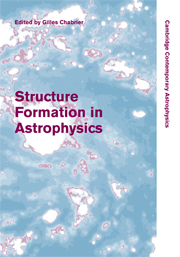Book contents
- Frontmatter
- Contents
- List of contributors
- Preface
- Part I Physical Processes and Numerical Methods Common to Structure Formations in Astrophysics
- Part II Structure and Star Formation in the Primordial Universe
- 6 New frontiers in cosmology and galaxy formation: challenges for the future
- 7 Galaxy formation physics
- 8 First stars: formation, evolution and feedback effects
- Part III Contemporary Star and Brown Dwarf Formation
- Part IV Protoplanetary Disks and Planet Formation
- Part V Summary
8 - First stars: formation, evolution and feedback effects
Published online by Cambridge University Press: 11 August 2009
- Frontmatter
- Contents
- List of contributors
- Preface
- Part I Physical Processes and Numerical Methods Common to Structure Formations in Astrophysics
- Part II Structure and Star Formation in the Primordial Universe
- 6 New frontiers in cosmology and galaxy formation: challenges for the future
- 7 Galaxy formation physics
- 8 First stars: formation, evolution and feedback effects
- Part III Contemporary Star and Brown Dwarf Formation
- Part IV Protoplanetary Disks and Planet Formation
- Part V Summary
Summary
Abstract
The formation of the first stars at redshifts z ~ 20–30 marked the transition from the simple initial state of the universe to one of ever increasing complexity. We here review recent progress in understanding their formation process with numerical simulations.We discuss the physics behind the prediction of a top-heavy primordial initial mass function (IMF) and focus on protostellar accretion as the key unsolved problem. We continue by describing their evolution and their death as energetic supernovae (SNe) or massive black holes. Finally, we address feedback processes from the first stars that are now realized to hold the key to our understanding of structure formation in the early universe. We discuss three broad feedback classes (radiative, chemical and mechanical) and explore the enrichment history of the intergalactic medium (IGM).
Introduction
How did the first stars in the universe form, how did they evolve and die and what was their impact on cosmic history (Woosley et al. 2002; Bromm & Larson 2004; Ciardi & Ferrara 2005)? The first stars formed at the end of the cosmic dark ages beyond the current horizon of observability (Couchman & Rees 1986; Haiman et al. 1996; Tegmark et al. 1997). These so-called Population III (Pop III) stars ionized (Kitayama et al. 2004; Whalen et al. 2004; Alvarez et al. 2006; Johnson et al. 2007) and metal-enriched (Furlanetto & Loeb 2003; Tornatore et al. 2007) the intergalactic medium (IGM) and consequently had important effects on subsequent galaxy formation (Barkana & Loeb 2001; Mackey et al. 2003).
- Type
- Chapter
- Information
- Structure Formation in Astrophysics , pp. 180 - 202Publisher: Cambridge University PressPrint publication year: 2009
- 1
- Cited by



